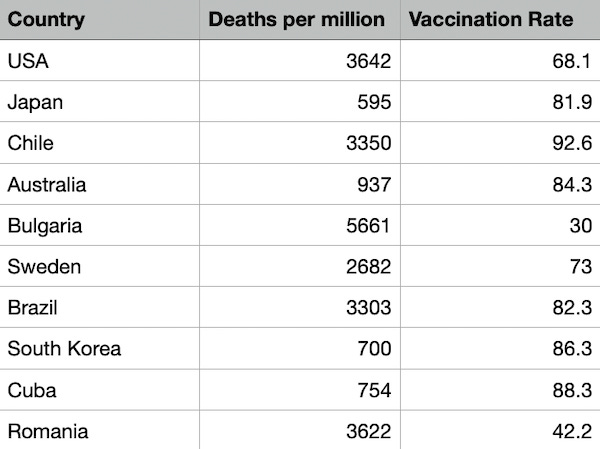One of the widely circulated claims during the pandemic was that COVID-19 vaccines—while not preventing infection or halting transmission—could reduce the severity of illness and keep people out of the hospital. Over time, however, public messaging shifted as it became increasingly evident that the vaccines weren’t functioning in the traditional sense of long-term sterilizing immunity.
There remains intense debate around the safety and efficacy of the COVID-19 shots. Researchers like Nicholas Hulcher, Dennis Rancourt and Jessica Rose have analyzed VAERS (Vaccine Adverse Event Reporting System) data and, based on underreporting estimates, have suggested that at least 600,000 Americans may have died as a result of the vaccines. If accurate, that figure would imply millions of vaccine-related deaths worldwide. These estimates, of course, are controversial to some, but critical analysis leaves little doubt to the damage done.
Setting aside the pros and cons debate for a moment, I revisited some global data on vaccination rates and COVID-19 mortality from sources like Worldometer and Statista to explore whether any patterns could be observed. I randomly selected 10 countries and looked at two key metrics:
COVID-19 deaths per million
Percentage of the population fully vaccinated (defined here as receiving at least two doses)
We should note upfront that COVID-19 death counts are imperfect. There’s a legitimate question over whether individuals died from COVID or simply with COVID. This matters greatly when analyzing mortality data.
After plotting the data from these countries, a clear pattern emerged.
The chart reveals a significant negative correlation (correlation coefficient = –0.74) between vaccination rates and COVID-19 death rates. In plain terms: the higher the vaccination rate, the lower the death rate. This finding appears to support the mainstream view—so what explains the disconnect?
Could other factors be influencing the results? Population density might play a role. Take New York City, for example—an area with high mortality early in the pandemic, potentially driven more by policy decisions (like Governor Cuomo’s controversial nursing home directive) than by population health alone.
One striking anomaly in the dataset is India. With a population four times larger than the U.S., India reported only 379 COVID-19 deaths per million––more than nine times lower than the U.S. rate. This is surprising, given its population density and comparatively limited healthcare infrastructure. Could this be due, in part, to the use of alternative treatments? In Uttar Pradesh—a state of 230 million—authorities widely distributed Ivermectin, and the region saw remarkably low death rates. Did other Indian states follow a similar approach? And what percentage of the population actually received Ivermectin? These are questions that deserve further attention.
I’d be interested to hear a deeper statistical breakdown—perhaps someone like Steve Kirsch could weigh in, given his focus on vaccine data analysis.
So where does that leave us?
The data may suggest some effectiveness of the vaccines, at least at a population level. However, that doesn't negate the reports of severe adverse outcomes in otherwise healthy individuals, and for this reason alone, I would not change my stance on these shots. For some, the shots may have been a life-saving intervention; for many others, tragically, a death sentence.
As the dust settles, it’s crucial we take a clear-eyed look at the full picture—one that includes not just public health outcomes but also medical ethics, policy transparency, and accountability.






Thank you, Ely, for another insightful article.
What if the vaccines were never intended to kill lots of people rapidly?
During my basic training in the Australian Army, way back in the late 1980's, I learned that our role as military combatants in the field was not to kill the enemy outright, but to maim them - contrary to Hollywood action-movie folklore. When an enemy soldier is injured, it requires at least two others to tend to him, thereby diverting precious enemy resources and gradually diminishing their strength.
Might the purpose of the fake-vaccines not have been for a similar outcome, not to kill outright in most cases, but to maim the enemy (i.e.,us)?
In military jargon, a "soft kill" is a strategy aimed at incapacitating the enemy through non-destructive means. A "slow kill" is a related concept more aligned with deterrence or attrition strategies that impose gradual, persistent damage or strategic costs over time rather than immediate destruction. A soft kill can be part of a slow kill approach.
Given that our adversaries play the long game and that their role is to create chaos and destruction on a world scale, it would make sense to view these medical interventions as serving a range of purposes, from initially gauging public compliance or obedience with "mandates" to weakening large populations over time, diminishing our resources and causing long term harm and socio-economic destruction.
We outnumber them, but we also know that most of the world's leaders are Fabians. The Fabian strategy is a military approach that avoids large, direct battles and frontal assaults, instead focusing on gradually weakening the enemy over time through harassment, disruption of supplies, and lowering morale. It is essentially a war of attrition and indirection, designed to wear down a stronger opponent by avoiding decisive confrontations and prolonging the conflict until conditions favour the weaker side, them!
This, I think, best encapsulates the nature of our conflict. From what I’ve seen, however, no one has addressed this topic yet, certainly not the number-crunchers (i.e., epidemiologists and biostatisticians).